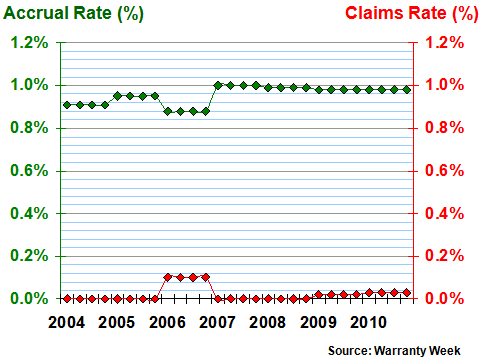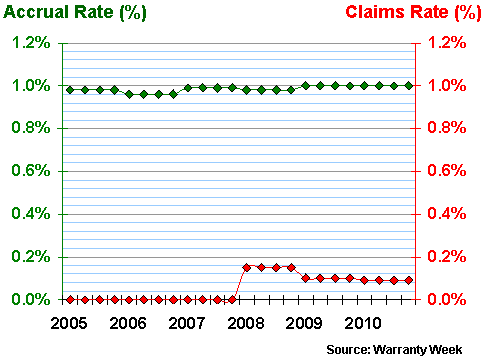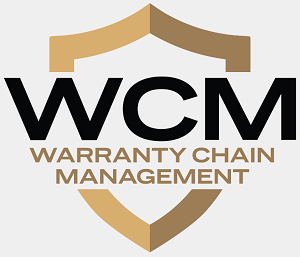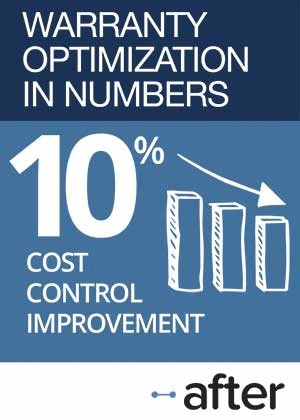Solar Warranties, Part 2:How the manufacturers of photovoltaic systems themselves explain the risks and metrics behind their product warranties, and how a few are securing warranty insurance to help reduce those risks.
Few manufactured products besides solar energy modules can be said to have 1) unusually long warranties, 2) brief histories and 3) rapidly advancing technologies.
Skate parts might have the first two, but a ramp is still a ramp. Tablet computers might have the last two, but a year's warranty is hardly lengthy.
Solar modules, however, have all three. Five, ten, and even 25-year warranties are common. The oldest land-based photovoltaic systems are now turning 30 years old, but most of the current installed base is less than five years old. And five years from now, one can reasonably expect entirely new photovoltaic technologies to be sold by entirely new companies.
In Part One last week, we detailed the warranty claims, accrual, and reserve balances of six different solar manufacturers. And we made the point that because both the industry and the products were so young, most of these companies were probably making their best guesses as to future failure rates and repair/replacement costs.
This week, in Part Two, we're going to let the companies speak for themselves. Or more precisely, we're going to collect some of the key phrases from their most recent annual reports, regarding how they decide on their accrual rates, how they use accelerated lifecycle tests to predict failure rates decades from now, and how some are admitting they know what they don't know.
Industry Standard Warranties
The industry standard product warranty for solar modules seems to be as follows: a five-year warranty against defects in materials and workmanship, and a 25-year warranty against reduced power output. Some of the product warranties are two years or six years. A few are 10 years. But almost all seem to go for the 25-year performance warranties, as if anything shorter would cause sales to stop.
The terms of the power output warranties do differ slightly from company to company. The industry standard specifies no more than a cumulative 10% drop in power output during years 1 to 10, and no more than a 20% drop during years 11 to 25.
Canadian Solar goes a step further than most, specifying the maximum annual decrease in precise detail. Rather than two giant steps, Canadian Solar's warranty has 25 baby steps -- one for each year of coverage. During the first year, Canadian Solar guarantees the actual power output of the module will be no less than 97% of the initial power output. And then, for every year thereafter, from year 2 to year 24, the company guarantees that the actual annual power decline will be no more than 0.7%. By the end of year 25, it guarantees that the actual power output will be no less than 80% of the labeled power output.
And then there's the question of how much all this is going to cost. Given that many of these solar installations are only a few years old, they're likely to be working spectacularly well. But how will they look in 10 years? How well will the brand new systems perform in 2036, when their warranties finally run out?
Choosing 1% Accruals
Canadian Solar, which we didn't cover in last week's newsletter, said it tries to keep its warranty accrual rate at exactly one percent of its net revenues. And it said it kept to that accrual rate both before June 2009, when its product warranties lasted only two years, and after June 2009, when its product warranties were lengthened to six years.
However, as can be seen in the chart below, Canadian Solar's accrual rates dipped as low as 0.9% in 2004 and again in 2006, when the product warranties were shorter. The terms of the company's performance warranties remained unchanged when the product warranties were lengthened. Ironically, however, 2006 was also the one and only year its claims rate ticked up to a measurable level, before falling back to 0% for two more years.
Figure 7a
Canadian Solar Inc.
Warranty Claims & Accrual Rates
(as a % of product sales, 2004-2010)
And then although we did cover Yingli Green Energy in last week's newsletter, we deleted its claims & accrual rate chart from the already graphics-heavy Part One of this report. We'll include that chart now to illustrate the point that we're trying to make: several solar companies have magically chosen this 1% number and are stubbornly sticking to it, no matter what happens to claims rates.
Figure 6a
Yingli Green Energy Holding Co. Ltd.
Warranty Claims & Accrual Rates
(as a % of product sales, 2004-2010)
And of course, being as most of the claims are likely to arise when the systems get old, who can say that one percent isn't the precisely correct accrual rate? Yingli's oldest installations will turn eight years old next month. So although they still have decades left on their performance warranties, at least the product warranties are beginning to expire. And if anything, the claims emergence data for 2008-2010 seems to suggest that perhaps one percent might even be too high.
JA Solar Holdings Co. Ltd., which has the distinction of never having paid a warranty claim in its entire history, has nevertheless also selected one percent as its ideal accrual rate. And it readily admits to copying that rate from others in the industry. "Through our relationships with, and management�s experience working at, other solar power companies and on the basis of publicly available information regarding other solar power companies� accrued warranty costs, we believe that accruing 1% of our net revenues from sales of solar modules as warranty costs is within the range of industry practice and is consistent with industry-standard accelerated testing, which assists us in estimating the long-term reliability of solar modules, estimates of failure rates from our quality review and other assumptions that we believe to be reasonable under the circumstances," the company suggests.
Evergreen Solar, meanwhile, said in its annual report that it aims to accrue only 0.5% of its product revenue. But in actual practice, the accrual rate has wobbled a bit, rising above 2.0% in early 2007 and falling below 0.2% in early 2009. But in 7 of the last 15 quarters, it's hit 0.5% precisely.
Shorter Warranties
By the way, the companies that make the machinery that is used to manufacture solar energy modules are usually much less generous with their warranties than the end-user-facing companies. For instance, Applied Materials Inc., the world's largest provider of solar wafer and cell manufacturing systems, covers its products with only a one-year warranty. Spire Corp. also warrants its solar manufacturing equipment for only one year. But labor is covered for just the first 90 days, while parts are covered for the entire year.
And we should also note that the solar energy industry is really comprised of multiple segments. You can split it into land-based and not-land-based systems. And you can split the land-based portion into residential, commercial, and utility segments.
In most instances, when we're talking about solar modules and 25-year performance warranties, we're talking about systems installed on the roofs of homes or office buildings that provide a few kilowatts of power. But then there are also the huge installations sold to electrical utilities and other customers who like to measure their output in millions of watts.
Those huge systems usually get much shorter warranties. For instance, First Solar warrants the solar power plants it builds for a period of only one year, "following the substantial completion of a solar power plant or an energized section of a solar power plant."
In contrast, SunPower Corp. covers its Satcon Power Systems with a 10-year warranty. The SunPower Oasis Power Plant has a 10-year warranty on the solar panels (with an additional 25-year performance warranty) and promises of on-site service.
Other competitors in what SunPower calls the Utility and Power Plants market segment include Abengoa Solar S.A., Acconia Energia S.A., AES Solar Energy Ltd., Chevron Energy Solutions, EDF Energy plc, NextEra Energy Inc., OPDE Group, Sempra Energy, Solar Millennium AG, Solargen Energy Inc., SunEdison, and Tessera Solar International Ltd.
Remote Monitoring Services
In order to better compete with them, SunPower goes a step further by installing performance monitoring software to keep tabs on its customers' solar systems. According to its annual report, "systems under warranty and systems under a performance monitoring contract use our proprietary software systems to collect and remotely analyze equipment operating and system performance data from all of our sites in our offices located in the United States and the Philippines."
All SunPower customers get that as part of their basic warranty. And then on top of that the company sells two levels of extended warranties: "We offer our customers a comprehensive suite of solar power system maintenance services ranging from system monitoring, to preventive maintenance, to rapid-response outage restoration and inverter repair. Our Standard Monitoring Service Agreement includes continuous remote monitoring, system performance reports, and a 24/7 technical support line. Our Basic Service Level Agreement adds preventive maintenance to the Standard Monitoring Services Agreement, and our Plus Level Service Agreement includes all of the Basic Service Level Agreement features plus on-site corrective maintenance using regionally-located field service technicians."
Swift Technological Changes
The biggest unknown is what will become of these systems in five, ten, or twenty years. For instance, let's say that a brand new state of the art residential rooftop system delivers two kilowatts of power in 2011. It's therefore warranted to deliver no less than 1.6 kilowatts until 2036.
But what if the state of the art system in 2020 can provide two megawatts in the space of a single rooftop? And what if it turns out that the systems installed today are so weather-beaten when they get to be ten years old that they need to be replaced? If the technology is advancing that quickly, and wearing out that soon, who would want merely a repair?
That's a question that only time can answer. Last week, we showed how even some of the companies with the most mature installed bases aren't really keeping more than 10 years of funds on hand to pay claims. And this we take as evidence that the 25-year performance warranties are more about marketing and peace-of-mind than about keeping systems operational for long periods of time.
But that opens up yet another question: How long will these systems really last? It's one thing to install them in the middle of the Arizona desert where the sun always shines and the rain never freezes. It's another to place them on a roof in Scandinavia that's covered in snow for several months each year.
The answer to that question is further complicated by the fast pace of technological change. Even if we can point to 15-year-old systems in 2011 that are doing just fine, they're made of materials that may no longer be in use. And while there are tests that can simulate 15 years of weather-beating, the only way to be sure is to install and operate a system for 15 years.
Accelerated Aging Process
SunPower said it performs highly accelerated lifecycle tests, which "expose our solar panels to extreme stress and climate conditions in both environmental simulation chambers and in actual field deployments in order to highlight potential failures that would occur over the 25-year warranty period. Due to the long warranty period, we bear the risk of extensive warranty claims long after we have shipped product and recognized revenue. Although we conduct accelerated testing of our solar panels and have several years of experience with our all-back-contact solar cell architecture, our solar panels have not and cannot be tested in an environment that exactly simulates the 25-year warranty period and it is difficult to test for all conditions that may occur in the field."
Others echo that uncertainty. According to First Solar's annual report, "Researchers began developing thin-film semiconductor technology over 20 years ago, but were unable to integrate the technology into a solar module production line until several years ago. Our thin-film technology and solar modules may not have a sufficient operating history to confirm how our solar modules will perform over their estimated 25-year useful life. We perform a variety of quality and life tests under different conditions. However, if our thin-film technology and solar modules perform below expectations, we could lose customers and face substantial warranty expense."
As First Solar describes the problem in the "Risks" section of its annual report, at the end of the day, the test results just help you make better guesses. "Although our power output warranty extends for 25 years, our oldest solar modules manufactured during the qualification of our pilot production line have only been in use since 2001. Because of the limited operating history of our solar modules, we have been required to make assumptions regarding the durability and reliability of our solar modules. Our assumptions could prove to be materially different from the actual performance of our solar modules, causing us to incur substantial expense to repair or replace defective solar modules in the future. For example, our glass-on-glass solar modules could break, delaminate, or experience power degradation in excess of expectations, and our manufacturing operations could be subject to process variations that could cause affected modules to underperform compared to our expectations."
Canadian Solar, while stating that it also tests its products, readily admits to the same limitations. "Although we conduct quality testing and inspection of our solar module products, our solar module products have not been and cannot be tested in an environment simulating the up-to-25-year warranty periods," its annual report explains. "In particular, unknown issues may surface after extended use. These issues could potentially affect our market reputation and adversely affect our revenues, giving rise to potential warranty claims by our customers. As a result, we may be subject to unexpected warranty expense and associated harm to our financial results as long as 25 years after the sale of our products."
Suntech Power Holdings Co. Ltd., in its latest annual report, said it performs several tests to simulate how its solar products are likely to react to the elements. "We perform several tests to expose our photovoltaic modules to extreme weather and environmental simulation chambers and in actual field deployments in order to highlight potential failures that would occur over a 25-year warranty period," the company stated.
However, in the very next sentence the company concedes the limitations of such testing. "Although we routinely conduct testing of our solar panels, our solar panels have not and cannot be tested in an environment that exactly simulates the 25-year warranty period and it is difficult to test for all conditions that may occur after an installation. We have sold PV modules since 2002 and have therefore not tested the full warranty cycle."
Lag Time for Claims
The cost of defects, even when caught quickly, can nevertheless be huge. First Solar, in its latest annual report, described what it called a "manufacturing excursion," which it said may end up costing the company $37.9 million by the time the excursion is over. "During the period from June 2008 to June 2009, a manufacturing excursion occurred affecting less than 4% of the total product manufactured within the period. The excursion could result in possible premature power loss in the affected modules. The root cause was identified and subsequently mitigated in June 2009. On-going testing confirms that the corrective actions taken are effective. We have been working directly with impacted customers to replace the affected modules and these efforts are well underway and, in some cases, complete.
"Some of these efforts go beyond our normal warranty coverage. Accordingly, we accrued additional expenses of $30.8 million in 2010 and $37.9 million in total-to-date to cover the replacement of the anticipated affected module population in the field. Such amounts include $8.5 million in expenses accrued during the fourth fiscal quarter of 2010, reflecting updated best estimates of the total replacement costs, based on our field data and execution to date of the module replacement program," the First Solar annual report stated.
Supplier Warranty Problems
And then there's the problem that occurs when a company is assembling solar energy systems with components sourced from suppliers. Let's put aside the questions of quality or reliability for a second. Instead, let's ask where these suppliers will be in 2036? And how much will they want for spare parts for 25-year-old systems?
In terms of reliability, one has to wonder about catastrophic losses caused by defective components. For instance, let's assume for a moment that there's some flammable liquid within a badly-designed component of the system, which leaks out after its container corrodes, causing a fire that burns the home to the ground. But it doesn't happen until 2025. What supplier warranty would cover the cost of such a claim? At most, they'd pay to fix the leak. As for the fire, that's a lawsuit, not a warranty claim.
SunPower addresses some of these risks in its annual report. "Our warranties may exceed the period of any warranties from our suppliers covering components, such as third party solar cells, third party panels and third party inverters, included in our systems. In addition, manufacturer warranties may not fully compensate us for losses associated with third-party claims caused by defects or quality issues in their products. For example, most manufacturer warranties exclude many losses that may result from a system component's failure or defect, such as the cost of de-installation, re-installation, shipping, lost electricity, lost renewable energy credits or other solar incentives, personal injury, property damage, and other losses. In certain cases our direct warranty coverage provided by SunPower to our customers, and therefore our financial exposure, may exceed our recourse available against cell, panel or other manufacturers for defects in their products. In addition, in the event we seek recourse through warranties, we will also be dependent on the creditworthiness and continued existence of the suppliers to our business."
Entech Solar Inc. uses extremely similar language in its annual report: "Warranty and product liability claims may result from defects or quality issues in certain third-party technology and components incorporated into our solar products, over which we have no control. Warranty provisions may not fully compensate us for any loss associated with third-party claims caused by defects or quality issues in such products. In the event we seek recourse through warranties, we will also be dependent on the creditworthiness and continued existence of our suppliers."
Installer Warranty Problems
In its annual report, we have Westinghouse Solar worrying about something entirely different: Divesting its warranty liabilities to an installation company. In effect, Westinghouse is becoming its installation company's supplier. The risk here is that the installer could go out of business, in which case all the warranty liabilities (and perhaps none of the accruals) would contractually revert back to Westinghouse Solar.
"In connection with our exit from the solar system installation business in California, we assigned a large number of our remaining installation project commitments to Real Goods Solar Inc. (RGS)," Westinghouse Solar stated in its annual report. "Under these arrangements, approximately 110 solar panel installation projects we had under contract with SunRun and for which construction has not yet begun were assigned to RGS. RGS assumed full installation and warranty responsibility for these projects.
"In addition, RGS agreed to undertake primary, 'first responder' responsibility for future warranty service obligations relating to the approximately 800 installations for SunRun that we have previously completed or will bring to completion as we transition out of the installation business. We retain secondary warranty responsibility [on these installations], in the event that RGS fails to perform the warranty.
"We will reimburse RGS for actual warranty service work completed by RGS related to these 'first responder' installations. To the extent that RGS fails to perform under the assigned installation projects or the assigned warranty coverage, we could incur significant unexpected additional expenses, which would adversely affect our results of operations," Westinghouse Solar predicted.
Warranty Insurance
Of course, there's a difference between a warranty claim and a product liability lawsuit. We're not attorneys, but in plain language a warranty claim is something that broke, which can be fixed. A product liability lawsuit is much bigger -- like a house burning down because of a leak, or a neighbor getting electrocuted when the water pipes are crossed with live wires.
Of course, there's also a difference between product warranty insurance and product liability insurance. Warranty insurance is quite rare. Most manufacturers self-insure, which is to say they don't insure the risk that they will have to pay claims. As long as their claims rate stays in single digits, they'll probably be fine.
Product liability insurance covers much bigger risks. And there's usually some deductible involved, making it relevant only in cases where a major loss is alleged. Sometimes, manufacturers decide to go without coverage, choosing to self-insure any payments. Other times, some degree of product liability coverage is included within a general liability insurance policy.
Entech Solar has neither warranty insurance nor product liability insurance, but at least it understands the risks: "We may be subject to warranty and product liability claims in the event that our solar products fail to perform as expected or if a failure of our solar products results, or is alleged to result, in bodily injury, property damage or other damages.
"It is possible that our products could result in injury, whether by product malfunctions, defects, improper installation or other causes. Moreover, we may not have adequate resources in the event of a successful claim against us. We rely on our general liability insurance to cover product liability claims and have not obtained separate product liability insurance. A successful warranty or product liability claim against us that is not covered by insurance or is in excess of our available insurance limits could require us to make significant payments of damages," Entech Solar states in its annual report.
Buying Warranty Insurance Policies
We could find only two instances where solar manufacturers actually insured their product warranties. This, we suspect, is the case because the industry is so young, and is the case despite their warranties being so long. That may change, however, after the collapse of Solyndra LLC teaches customers a hard lesson: uninsured warranties are only as good as the company that issues them.
The two cases where we found warranty insurance to be in force were at Canadian Solar and Suntech. Canadian Solar said it began to insure its product warranties in April 2010, purchasing product warranty insurance from A-rated insurance companies on an annual basis. "Under the policies, the insurance companies cover the liabilities listed on our warranty statement up to certain maximum claim limits and subject to certain deductibles," the company stated. "This insurance applies to our warranty against workmanship and material defects and our warranty against power output. This insurance cost is amortized over the 25 year coverage period provided under the insurance policies. However, our customers will enjoy an irrevocable warranty, which may improve the marketability of our products and entice them to pay more for products with warranties backed by insurance."
Canadian Solar added that the unamortized carrying value of prepaid insurance was $5,593,524 as of December 31, 2010, and was included as a component of other non-current assets in the consolidated balance sheets. At the end of last year, the company's warranty reserve fund balance was $31,224,906. During the same year, it reported warranty accruals of $14,707,513.
Suntech said it also carries product warranty insurance, though it provided significantly less detail. As we noted in last week's newsletter, Suntech is a Chinese manufacturer that not only trades its shares on a U.S. exchange, but also keeps its books in U.S. dollars. As of the end of 2010, the company carried a warranty reserve balance of $81 million, having made $28.8 million in accruals during the year while paying only $3 million in claims. So if the same ratios were at work, Suntech's warranty insurance would also have a much higher carrying value.
Part 3: Solar Warranty Insurance
Next week, in a third and final part to this series, we'll take a deeper look into the benefits of warranty insurance for both manufacturers and customers.
| 











